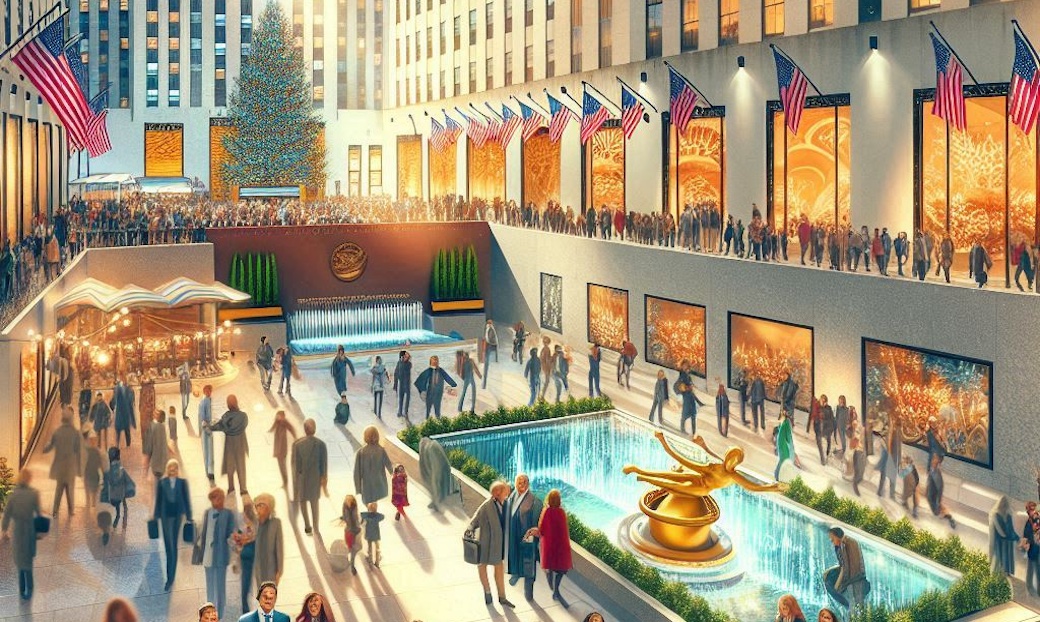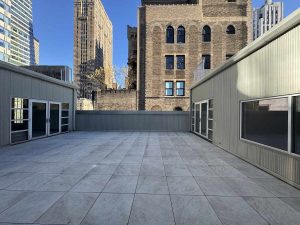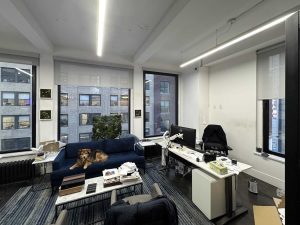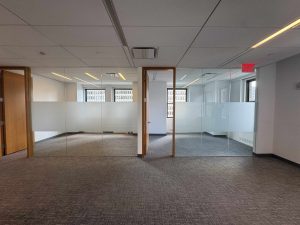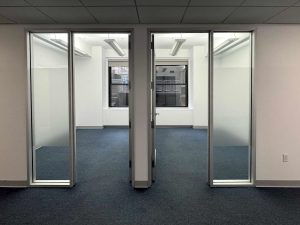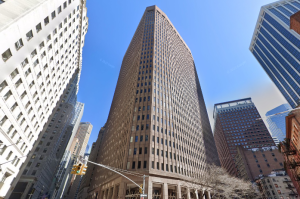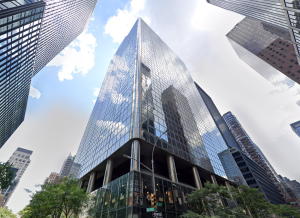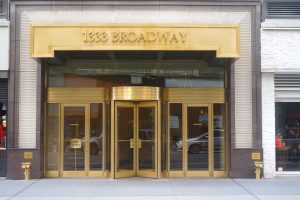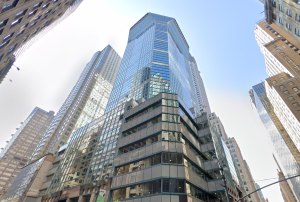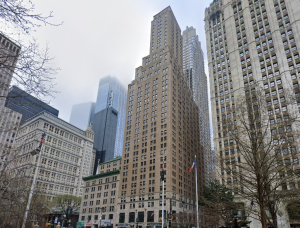Walking down a Midtown Manhattan street today still feels different from what you remember before the pandemic, right? The sidewalks are a bit emptier, and when you glance up at the office buildings, you can’t help but notice how many windows are dark. In fact, about 23% of offices in all of Manhattan are sitting empty right now.
It’s been a rocky few years for this part of town, but don’t write off Midtown just yet. Things are starting to look up, even if it’s a slow climb. This past July, we saw more businesses signing leases – specifically a 60% increase. And in the middle of all this, there’s one place that’s continued to catch people’s attention: Rockefeller Center.
While other submarkets and buildings struggle to get back on their feet, Rock Center is teeming with activity. Under Tishman Speyer’s leadership, Rockefeller Center is reinventing itself for a new era. They’re not just waiting for things to get better – they’re actively making changes.
Walk through Rockefeller Center today, and you’ll see it. The skating rink looks fresh, new restaurants are opening, and the office spaces look modernized. It’s like watching a classic car get a modern engine – all the charm of the old with the power of the new.
The Visionary Management of Tishman Speyer: Rockefeller Center’s Renaissance
When Rockefeller Center hit rock bottom in the 1990s, few believed it could reclaim its former glory. Then, one of NYC’s most prominent landlords Tishman Speyer threw its hat in the ring with capital and a bold vision to turn a struggling landmark into a thriving urban oasis.
From Ticket Offices to Bankruptcy: Rockefeller Center’s Fall from Grace
Rockefeller Center’s decline wasn’t sudden—it was a slow burn that started in the late 20th century. Once an elegant center of commerce and culture, the complex gradually lost its luster. Retail spaces morphed into dull airline ticket offices, stripping away the vibrant shopping experience that once drew crowds. The office spaces, once the height of corporate prestige, grew outdated and struggled to compete with sleek new skyscrapers popping up across Manhattan.
The final blow came in the early 1990s. Burdened by heavy mortgages and caught in an economic downturn, Rockefeller Center’s owners, including Mitsubishi Estate Company and the Rockefeller family trusts, filed for bankruptcy in 1995. The $1.3 billion debt seemed insurmountable. Rockefeller Center, the jewel of Midtown, had officially lost its shine.
Tishman Speyer’s $300 Million Bet on the Future
Tishman Speyer strutted in during 2000 with a $1.85 billion check and a whole lot of optimism. But that was only the beginning. CEO Rob Speyer had a wild idea: What if Rockefeller Center could become more than a boring office complex?
So they poured a cool $300 million into renovations. They doubled the concourse ceiling height, making it feel less like a cave and more like an airy urban playground. They added a half-acre rooftop park because who doesn’t want to sip coffee surrounded by skyscrapers? And let’s not forget the revamped “Top of the Rock” observation deck and its complete overhaul, offering breathtaking views that rivaled any in the city.
Tishman Speyer’s vision also went beyond physical renovations. They reimagined Rockefeller Center as a 24/7 destination where work, play, and culture intersect. Art installations popped up in unexpected corners. Food halls and high-end restaurants moved in, transforming the dining scene. Events and performances turned public spaces into stages, drawing crowds at all hours.
Even when COVID-19 hit, and everyone thought the city was down for the count, Tishman Speyer kept swinging. They got creative with health measures, tech upgrades, and flexible spaces that made “the new normal” feel almost… normal.
Which brings us to today. Rockefeller Center is the place to be whether you’re catching a surprise concert, trying the latest food craze, or impressing clients in a state-of-the-art office.
Rockefeller Center: Where Work Meets Play
Rockefeller Center is shedding its reputation as just another office complex. This NYC landmark is reinventing itself as a 24/7 mixed-use destination where work, shopping, dining, and culture collide. In one day, you can start your day with a power meeting, browse cutting-edge boutiques over lunch, and cap off the evening with a world-class meal without leaving the block.
Shop ‘Til You Drop
Stroll through Rockefeller Center today, and you’ll find a retail wonderland. Sure, Tiffany & Co. still sparkles at 610 Fifth Avenue, but now it has some seriously cool neighbors.
Music geeks are flocking to Rough Trade near Radio City. It’s a vinyl paradise that feels more East Village than Midtown. Fashion lovers are buzzing about Hill House Home at 60 W 50th Street – home of the internet-famous Nap Dress™ (yes, it’s a thing).
McNally Jackson at 1 Rockefeller Plaza is also the indie bookstore’s largest NYC location yet- and it’s massive. It’s become a literary hotspot with author events and a stationery section that’ll make you want to hand-write everything.
With all these retail spots from all across the spectrum breathing new life into the 9-to-5 grind, suddenly, grabbing lunch turns into an afternoon of window shopping. What’s more, it’s a chance for visitors to snag some only-in-New-York finds alongside that obligatory Christmas tree selfie.
From Power Lunches to Destination Dining
Forget sad desk salads – Rockefeller Center has transformed into a bona fide culinary hotspot. In 2022, a wave of trendy restaurants and bars crashed onto the scene, and it was no accident. Tishman Speyer, the complex’s owner, partnered with hospitality experts to curate a dining experience that could rival downtown’s coolest spots. Their mission? To create a food scene so irresistible that New Yorkers would willingly trek to Midtown on weekends. The result is a diverse restaurant lineup that caters to every palate and occasion.
Take Le Rock, for instance, where the team behind Frenchette serves up French classics with a modern twist. Or Jupiter, which opened in November 2022, offering regional Italian fare with a side of ice rink views. You also have Midwestern comfort food at 5 Acres, excellent coffee houses like % Arabica, and New York (and Detroit-style) pizza at Ace’s Pizza. And if high-end Korean is your thing, head to Naro or indulge at a classic brasserie at 21 Greenpoint- there’s something for everyone. There’s also Pebble Bar, a four-story townhouse backed by celebrities like Pete Davidson and Mark Ronson for after-work drinks.
That only scratches the surface, too. Rockefeller Center has quickly evolved from a place where you’d grab a quick bite between meetings to a go-to spot for date nights, family outings, and impressing out-of-town guests.
Rockefeller Center Reinvents Itself for the Hybrid Work Era
We’re approaching the latter part of 2024, and Rockefeller Center continues defying expectations. Rockefeller Center boasts a 93% office occupancy rate, which is no small feat, while Midtown’s rate sits around 83.9%. How are they pulling this off?
Keeping Offices Full in a Remote-First Job Market
Rockefeller Center’s secret lies in giving tenants what they truly need. Co-working spaces foster collaboration for teams who might only gather occasionally. A swanky clubhouse provides a place to unwind or network. Even bike storage encourages eco-friendly commutes for those who’ve ditched the subway.
Rockefeller Center’s tenant app ties it all together. Need to book a conference room or report a maintenance issue? It’s all at your fingertips. The app even keeps you in the loop about community events, making the workplace feel vibrant and connected.
Luring the Part-Time Workforce
With only 70% of workers back in offices regularly, Rockefeller Center had to get creative. Their strategy? Make the complex irresistible, even if you’re only there a few days a week.
Food is a major draw, and we already discussed some of Rockefeller Center’s top options. But beyond the food and drinks, Rockefeller Center also oozes culture. Public art installations pepper the campus. A podcast studio, Newsstand Studios, produces original content and welcomes tenant use. Seasonal events, art shows, and live performances keep the energy high year-round.
Even weekends have a lot to offer. Summer brings al fresco dining and movie nights to the iconic rink area. Project 91 hosts electronic music events for those looking to blow off steam. And the R-CADE pop-up, a collaboration with Barcade, offers retro gaming fun for all ages.
The Rockefeller Center Cultural and Amenity Ecosystem
Rockefeller Center has shed its suit and tie. Once the buttoned-up epicenter of New York’s business world, it now struts its stuff as one of the city’s coolest hangout spots. Forget stuffy boardrooms – we’re talking ice skates, rooftop gardens, and A-list chefs.
Cultural and Entertainment Attractions
Step into Radio City Music Hall, and you’ll step into showbiz history. Over a million people a year pack the house for everything from rock concerts to high-kicking Rockettes. Come winter, 150,000 would-be figure skating champs twirl and tumble on the outdoor rink.
Want a bird’s-eye view? Join the 2.5 million yearly visitors who zip up to Top of the Rock. For real daredevils, “The Beam” cranks you 12 feet higher, letting you channel your inner 1930s construction worker (minus the lack of safety harnesses).
Art enthusiasts get their fix too. The “Art in Focus” series splashes larger-than-life installations across the plaza, turning concrete into canvas. It’s not just pretty – all these attractions pump serious cash into local shops and restaurants.
Building Community and Experiences
Rockefeller Center’s got a secret weapon in the fight against concrete jungle fever: Radio Park. This 24,000-square-foot rooftop oasis gives frazzled New Yorkers a place to breathe easily (and host a swanky party, casual meetings, or grand fundraiser).
Again, we can’t stress enough how many top-tier restaurant groups and celebrated chefs now call Rockefeller Center home, luring New Yorkers and tourists with innovative menus and exceptional dining experiences. But beyond that, when the sun sets, the tunes crank up. Music fills the air throughout the year, with partnerships bringing electronic music series and live performances to the plaza. During summer, the ice rink transforms into an al fresco cultural hotspot, serving a perfect blend of food, drinks, and melodies. And come 2026, the swanky 130-room Little Nell Hotel will give visitors a place to crash after all that partying (or “networking”).
Final Thoughts
While parts of Manhattan still struggle to recapture that pre-pandemic magic, Rockefeller Center is bucking the trend. It’s gone from being just another office complex to the kind of place where New Yorkers actually want to hang out. Think rooftop gardens for afternoon meetings, restaurants run by top chefs, and surprise concerts in the plaza. This didn’t happen by magic—it took a boatload of cash and some bold thinking from Tishman Speyer.
Rockefeller Center’s comeback is a wake-up call for the rest of Midtown. As other buildings sit half-empty, it shows that with some creativity and a willingness to shake things up, even the most old-school spaces can find new life. It’s about understanding what people want from their city nowadays—a mix of work, play, and culture all rolled into one.
Not everyone can drop millions on a makeover, but the lesson is clear: adapt or get left behind. As we figure out what post-pandemic life looks like, Rockefeller Center is giving us a glimpse of a future where our cities are more vibrant and exciting than ever. And let’s be honest, who wouldn’t want to be part of that? | Rockefeller Center Rocks On: How an NYC Icon Defied the Office Exodus
